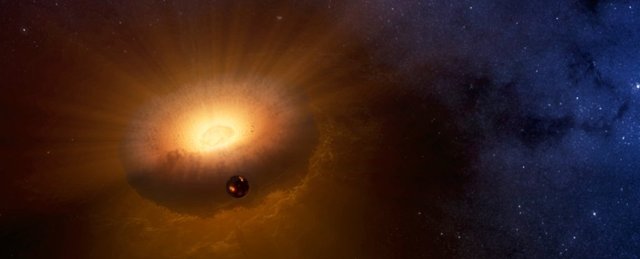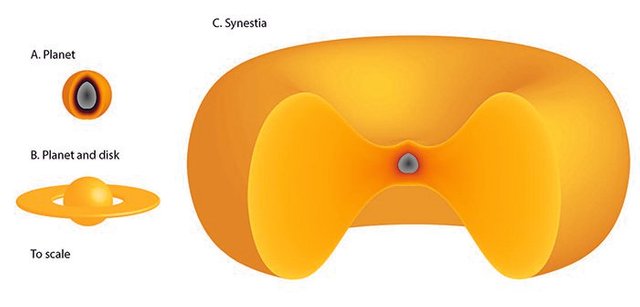Scientists Have a Crazy New Hypothesis About The Origin of The Moon

The usual explanation for the origin of the Moon describes it as the result of a collision between Earth and something else that spun material into space.
But a new paper suggests that our satellite could have emerged from the ring of a vapourised planet - and this could answer some inconsistencies left by the collision theory.
Called a synestia, and still only hypothetical, the vapourised planet is a relatively new concept.
It's a doughnut-shaped, rapidly spinning cloud of rock and dust that can constitute part of the formation of rocky planets.
According to a paper published last year, by Harvard graduate student Simon Lock and UC Davis planetary scientist Sarah Stewart, a synestia occurs when two planet-sized objects within the protoplanetary disc collide, resulting in the torus-shaped cloud of hot dust and liquid rotating around a molten core.
This then collapses back down under its own gravity to become a planet.

According to a new paper, also led by Lock and Stewart, it was inside Earth's synestia that the Moon formed, rather than a collision with a Mars-sized body called Theia 4.5 billion years ago that threw material into Earth's orbit.
"The new work explains features of the Moon that are hard to resolve with current ideas," Stewart said.
"The Moon is chemically almost the same as the Earth, but with some differences. This is the first model that can match the pattern of the Moon's composition."
The Moon and Earth are made up of similar elements, which is consistent with the broken off chunk, but there are some differences that remain puzzling.
For instance, relative to Earth, the Moon is far less abundant in volatile elements such as copper, potassium, sodium and zinc.
"There hasn't been a good explanation for this," Lock said.
"People have proposed various hypotheses for how the Moon could have wound up with fewer volatiles, but no one has been able to quantitatively match the Moon's composition."
In Lock and Stewart's theory, Theia can still exist and still collide with Earth, but rather than breaking part off the forming planet to create a ring that eventually turned into the Moon, it pulverised it, creating a synestia.
Around 10 percent of Earth would have been vapourised, and the rest would be liquid rock, the researchers said. Within this would be the seed of the Moon, a relatively small piece of liquid rock just off the centre of the synestia.
As the synestia started to cool and fall towards its core, some of this liquid rock 'rain' would end up falling onto the Moon seed.
"Over time, the whole structure shrinks, and the Moon emerges from the vapour," Lock said. "Eventually, the whole synestia condenses and what's left is a ball of spinning liquid rock that eventually forms the Earth as we know it today."
This formation model would also solve the problem of the missing volatile elements, while fitting with the isotopic similarities, since both Earth and Moon formed from the same synestia.
But since the Moon formed surrounded by pressures of tens of atmospheres of vapour, and at temperatures between 2,200 and 3,300 degrees Celsius (4,000 and 6,000 Fahrenheit), this would have evaporated the elements in question.
The work, however, is still very much in progress. To start with, synestias have never been observed, and still have to be proven to exist. Testing of lunar material can also help figure out how likely the scenario is.
"This is a basic model. We've done calculations of each of the processes that go into forming the Moon and shown that the model could work, but there are various aspects of our theory that will need more interrogation," Lock said.
"For example, when the Moon is in this vapor, what does it do to that vapor? How does it perturb it? How does the vapor flow past the Moon? These are all things we need to go back and examine in more detail."
The research has been published in the Journal of Geophysical Research.